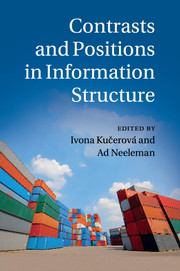Book contents
- Frontmatter
- Contents
- List of Contributors
- 1 Introduction
- Part I The architecture of grammar and the primitives of information structure
- Part II Exploring the interfaces: case studies
- 8 NP ellipsis without focus movement/projections: the role of Classifiers
- 9 Focus in Greek wh-questions
- 10 Against FocusP: arguments from Zulu
- 11 Scrambling as formal movement
- 12 Left-peripheral arguments and discourse interface strategies in Yucatec Maya
- Bibliography
- Index
11 - Scrambling as formal movement
from Part II - Exploring the interfaces: case studies
Published online by Cambridge University Press: 05 August 2012
- Frontmatter
- Contents
- List of Contributors
- 1 Introduction
- Part I The architecture of grammar and the primitives of information structure
- Part II Exploring the interfaces: case studies
- 8 NP ellipsis without focus movement/projections: the role of Classifiers
- 9 Focus in Greek wh-questions
- 10 Against FocusP: arguments from Zulu
- 11 Scrambling as formal movement
- 12 Left-peripheral arguments and discourse interface strategies in Yucatec Maya
- Bibliography
- Index
Summary
Introduction and overview
The choice of a marked word order typically goes hand in hand with a marked pragmatic potential. Quite a number of different accounts for this observation have been proposed, which range from the direct encoding of pragmatic functions in the syntactic representation (as in the cartographic model of Rizzi 1997) to the idea that information structure plays no role at all for syntax, and is only loosely linked to surface structure, e.g., as a consequence of the prosodic properties of the sentence, or as a consequence of relatively high processing costs of marked structures.
In their analysis of movement to the left periphery (Spec,CP) in Czech and German, Fanselow and Lenertová (2011) argue for an indirect interaction of syntax and information structure. Movement is triggered by an unspecific edge feature of Comp (in the sense of Chomsky 2008), and the choice of the category to be moved is constrained by the theory of linearization (adapted from Fox and Pesetsky 2005) rather than by considerations of information structure.
- Type
- Chapter
- Information
- Contrasts and Positions in Information Structure , pp. 267 - 295Publisher: Cambridge University PressPrint publication year: 2012
- 5
- Cited by



